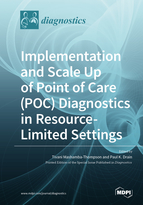Implementation and Scale Up of Point of Care (POC) Diagnostics in Resource-Limited Settings
A special issue of Diagnostics (ISSN 2075-4418). This special issue belongs to the section "Point-of-Care Diagnostics and Devices".
Deadline for manuscript submissions: closed (31 March 2020) | Viewed by 66616
Special Issue Editors
Interests: diagnostics; point of care testing; implementation; scale up; evaluation
Interests: HIV/AIDS; tuberculosis; point-of-care diagnostics; point-of-care testing; implementation science; global health; resource-limited settings
Special Issues, Collections and Topics in MDPI journals
Special Issue Information
Dear Colleagues,
Implementating, scaling up and sustaining health interventions is a challenge in practical contexts. The advent of POC diagnostics in resource-limited settings has the potential to improve health outcomes, particularly in disease-burdened countries. Despite recent investment in global health diagnostics, the potential for POC diagnostics to generate value for patients and health systems has not been met across all settings, particularly in low-and middle-income countries where disease burden is high and diagnosis remains a weak point in the health care cascade. Scale up and implementation of new of POC diagnostics in these setting is a global health priority to enable the adoption of new evidence-based POC diagnostics and to replicate and extend the reach of POC diagnostics. Global private and public sector agencies have significantly increased their investment in the development of POC diagnostics to meet the unmet needs of patients in resource-limited settings. However, previous research has demonstrated that the availability of health technologies in these settings does not always guarantee patient-centred outcomes.
The applicability, effectiveness and sustainability of diagnostic technologies is affected by the involvement of all stakeholders during planning and implementation, which must be relevant to each specific context and sensitive to local culture. Factors such as infrastructure, resources, values and characteristics of participants can influence the implementation, scalability and sustainability of health interventions such as POC diagnostics. This Special Issue “Implementation and Scale Up of Point of Care (POC) Diagnostics in Resource-Limited Settings” will include literature reviews and primary research studies focusing on the implementation and scale up of POC diagnostics in resource-limited settings.
Prof. Dr. Tivani Mashamba-Thompson
Dr. Paul K. Drain
Guest Editors
Manuscript Submission Information
Manuscripts should be submitted online at www.mdpi.com by registering and logging in to this website. Once you are registered, click here to go to the submission form. Manuscripts can be submitted until the deadline. All submissions that pass pre-check are peer-reviewed. Accepted papers will be published continuously in the journal (as soon as accepted) and will be listed together on the special issue website. Research articles, review articles as well as short communications are invited. For planned papers, a title and short abstract (about 100 words) can be sent to the Editorial Office for announcement on this website.
Submitted manuscripts should not have been published previously, nor be under consideration for publication elsewhere (except conference proceedings papers). All manuscripts are thoroughly refereed through a single-blind peer-review process. A guide for authors and other relevant information for submission of manuscripts is available on the Instructions for Authors page. Diagnostics is an international peer-reviewed open access semimonthly journal published by MDPI.
Please visit the Instructions for Authors page before submitting a manuscript. The Article Processing Charge (APC) for publication in this open access journal is 2600 CHF (Swiss Francs). Submitted papers should be well formatted and use good English. Authors may use MDPI's English editing service prior to publication or during author revisions.
Keywords
- point of care
- diagnostics
- implementation
- scale up








